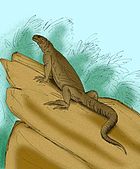| Priscagamidae Temporal range:
Late Cretaceous-
Eocene,
| |
|---|---|
|
Scientific classification
| |
| Domain: | Eukaryota |
| Kingdom: | Animalia |
| Phylum: | Chordata |
| Class: | Reptilia |
| Order: | Squamata |
| Suborder: | Iguania |
| Family: | †
Priscagamidae Borsuk-Białynicka and Moody, 1984 [1] |
| Genera | |
|
†
Heterodontagama | |
| Synonyms | |
Priscagamidae is an extinct family of iguanian lizards [1] known from the Late Cretaceous of Mongolia and China and the Eocene of India, [3] spanning a range from 83.6 to 48.6 million years ago. Probably the earliest priscagamids on indeterminate genera were found in Aptian- Albian sediments in "Hobur", Mongolia. [4] It includes the genera Heterodontagama, Mimeosaurus, Phrynosomimus, Priscagama, and possibly Pleurodontagama. [5] The first fossils of priscagamids were found in the Djadochta and Khermeen Tsav formations of Mongolia. [2] More recently they have been found in the Cambay Formation in India, leading to the naming of Heterodontagama in 2013. [6] Priscagamidae was originally described as a subfamily of Agamidae called Priscagaminae in 1984, [2] but it was reclassified as a distinct family in 1989. [1] Most phylogenetic analyses (analyses of evolutionary relationships) still find a close relationship between Priscagamidae and Agamidae (both have been grouped under a clade called Chamaeleontiformes [7]), although a 2015 study found it to be basal to all other iguanian clades, warranting its removal from Iguania and placement in a larger clade called Iguanomorpha. [8]
References
- ^ a b c Alifanov, V.R. (1989). "New priscagamids (Lacertilia) from the Upper Cretaceous of Mongolia and their systematic position among Iguania". Paleontological Journal. 4: 68–80.
- ^ a b c Borsuk-Białynicka, M.; Moody, S.M. (1984). "Priscagaminae, a new subfamily of the Agamidae (Sauria) from the Late Cretaceous of the Gobi Desert". Acta Palaeontologica Polonica. 29 (1–2): 51–81.
- ^ a b "†Priscagaminae Borsuk-Bialynicka and Moody 1984". Paleobiology Database. Fossilworks. Retrieved 6 November 2023.
- ^ V. Alifanov (1993). "Some peculiarities of the Cretaceous and Palaeogene lizard faunas of the Mongolian People's Republic". Darmstädter Beiträge zur Naturgeschichte. 3 (9–13).
- ^ Gao, K.; and Norell, M. (2000). "Taxonomic composition and systematics of late Cretaceous lizard assemblages from Ukhaa Tolgod and adjacent localities, Mongolian Gobi Desert". Bulletin of the American Museum of Natural History. 249: 1–117. doi: 10.1206/0003-0090(2000)249<0001:TCASOL>2.0.CO;2. hdl: 2246/1596. S2CID 129367764.
- ^ Rana, R.S.; Augé, M.; Folie, A.; Rose, K.D.; Kumar, K.; Singh, L.; Sahni, A.; Smith, T. (2013). "High diversity of acrodontan lizards in the Early Eocene Vastan lignite mine of India". Geologica Belgica. 16 (4): 290–301.
- ^ Daza, J. D.; Abdala, V.; Arias, J. S.; García-López, D.; Ortiz, P. (2012). "Cladistic analysis of Iguania and a fossil lizard from the Late Pliocene of northwestern Argentina". Journal of Herpetology. 46: 104–119. doi: 10.1670/10-112. hdl: 11336/61054. S2CID 85405843.
- ^ Conrad, Jack L. (2015). "A new Eocene casquehead lizard (Reptilia, Corytophanidae) from North America". PLOS ONE. 10 (7): e0127900. Bibcode: 2015PLoSO..1027900C. doi: 10.1371/journal.pone.0127900. PMC 4489568. PMID 26131767.
